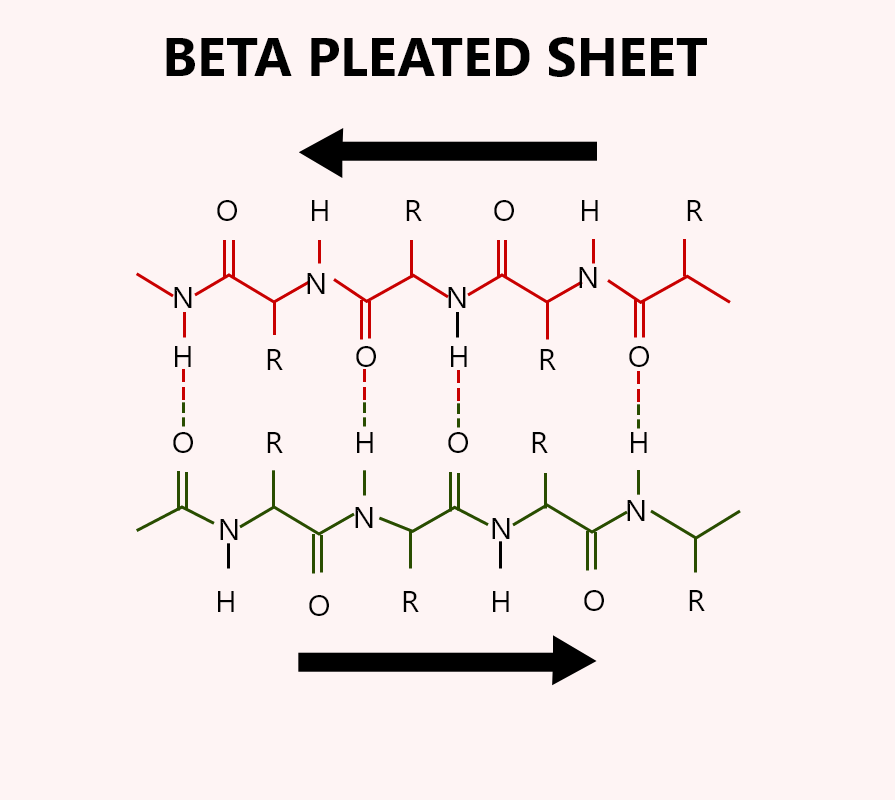
Two polypeptide chains are joined by hydrogen bonds to produce
A)Alpha helix
B)Tertiary structure
C)Beta pleated sheet
D)All of the above
Answer
489.9k+ views
Hint: It is a segment of a polypeptide chain that is lined next to each other and forms a structure that is stabilized by hydrogen bond form between carbonyl (CO) and N-H groups in the polypeptide backbone.
Complete answer:
Beta pleated sheets are formed when two or more than two polypeptide chains segments line up side by side and each individual segment is called a beta-strand. The beta-strand is fully extended.
-Beta pleated sheet held together by hydrogen bonds between carbonyl and the N-H group of the polypeptide backbone. Beta strands may be parallel, pointing in the same direction or antiparallel, pointing in the opposite direction.
-In an antiparallel sheet, adjacent strands run in the opposite direction, and hydrogen bonds between N-H and CO groups connect each amino acid to a single amino acid on the adjacent strand.
-In parallel sheet adjacent strands run in the same direction and a hydrogen bond connects amino acid on one strand with two different amino acids on the adjacent strand.
-For each amino acid the N-H group is hydrogen-bonded to the group of one amino acid on the adjacent strand.
Additional Information: Alpha helix - it is a rod-like structure that forms when a polypeptide chain is twisted into a helical conformation. It can be right-handed or left-handed.except for amino acid near the ends of an alpha helix, all the main chain CO and NH groups are hydrogen bonds.
Tertiary structure- it refers to the unique 3D conformation in which globular protein interactions between the side chains in their primary structure
So, the correct answer is, "beta-pleated sheet".
Note: Most proteins have a globular shape and require reversal in a direction of the polypeptide chain. These reversals are done by a common structural element called the turn.
-Turns are classified according to the separation between the two end residues participating in hydrogen bonds.
-They are alpha turns, beta-turn, and gamma turn.

Complete answer:
Beta pleated sheets are formed when two or more than two polypeptide chains segments line up side by side and each individual segment is called a beta-strand. The beta-strand is fully extended.
-Beta pleated sheet held together by hydrogen bonds between carbonyl and the N-H group of the polypeptide backbone. Beta strands may be parallel, pointing in the same direction or antiparallel, pointing in the opposite direction.
-In an antiparallel sheet, adjacent strands run in the opposite direction, and hydrogen bonds between N-H and CO groups connect each amino acid to a single amino acid on the adjacent strand.
-In parallel sheet adjacent strands run in the same direction and a hydrogen bond connects amino acid on one strand with two different amino acids on the adjacent strand.
-For each amino acid the N-H group is hydrogen-bonded to the group of one amino acid on the adjacent strand.
Additional Information: Alpha helix - it is a rod-like structure that forms when a polypeptide chain is twisted into a helical conformation. It can be right-handed or left-handed.except for amino acid near the ends of an alpha helix, all the main chain CO and NH groups are hydrogen bonds.
Tertiary structure- it refers to the unique 3D conformation in which globular protein interactions between the side chains in their primary structure
So, the correct answer is, "beta-pleated sheet".
Note: Most proteins have a globular shape and require reversal in a direction of the polypeptide chain. These reversals are done by a common structural element called the turn.
-Turns are classified according to the separation between the two end residues participating in hydrogen bonds.
-They are alpha turns, beta-turn, and gamma turn.

Latest Vedantu courses for you
Grade 10 | CBSE | SCHOOL | English
Vedantu 10 CBSE Pro Course - (2025-26)
School Full course for CBSE students
₹37,300 per year
EMI starts from ₹3,108.34 per month
Recently Updated Pages
Master Class 11 Economics: Engaging Questions & Answers for Success

Master Class 11 Business Studies: Engaging Questions & Answers for Success

Master Class 11 Accountancy: Engaging Questions & Answers for Success

Master Class 11 English: Engaging Questions & Answers for Success

Master Class 11 Computer Science: Engaging Questions & Answers for Success

Master Class 11 Maths: Engaging Questions & Answers for Success

Trending doubts
State and prove Bernoullis theorem class 11 physics CBSE

1 ton equals to A 100 kg B 1000 kg C 10 kg D 10000 class 11 physics CBSE

State the laws of reflection of light

One Metric ton is equal to kg A 10000 B 1000 C 100 class 11 physics CBSE

1 Quintal is equal to a 110 kg b 10 kg c 100kg d 1000 class 11 physics CBSE

Difference Between Prokaryotic Cells and Eukaryotic Cells




